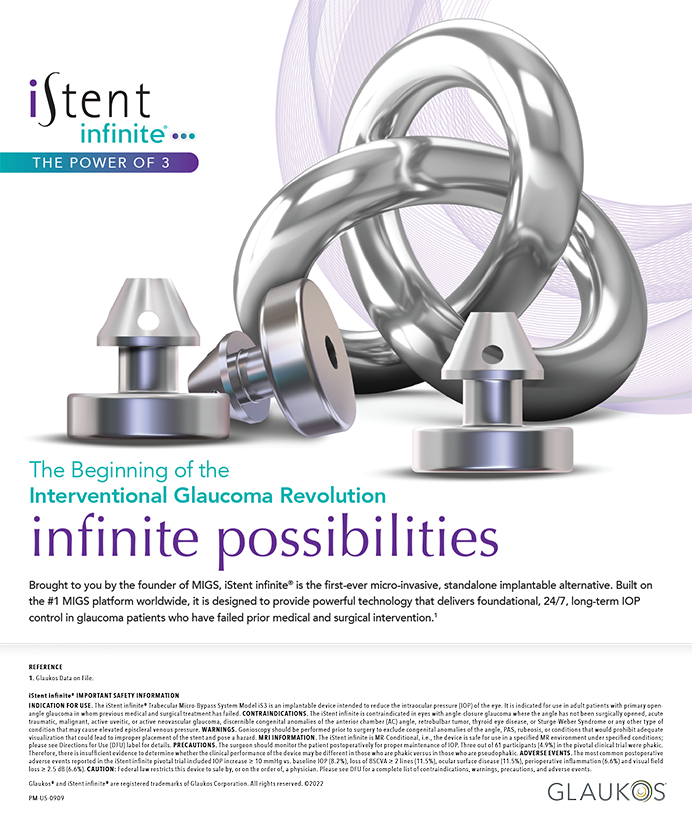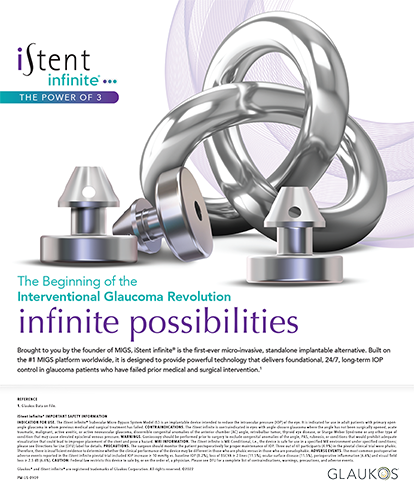Case Presentation
If the capsular bag is torn intraoperatively, most cataract surgeons agree that the ideal location for the IOL is either within the bag or in the sulcus with some form of optic capture if necessary. In cases of a severely damaged or lost capsular bag, what would be your preference for the IOL's fixation in the eye of a healthy 65-year-old patient? Would you opt for an ACIOL, a PCIOL sutured to the iris, or a PCIOL sutured through the ciliary sulcus? If your preference is either of the PCIOLs, what type of suture would you use?
PAUL N. ARNOLD, MD
If the incision remained 2.8mm after complete cataract extraction and the iris were intact and normal, I would suture a foldable PCIOL to the iris (á la Garry Condon, MD, of Pittsburgh1). If the patient were 85 years old, I would measure the diameter of the anterior chamber as accurately as possible and place the optimally sized MTA_UO ACIOL (blank signifying the lens' diameter; Alcon Laboratories, Inc., Fort Worth, TX) with four-point fixation. This lens has performed beautifully for me when accurately sized for the eye's diameter, but any movement can lead to glaucoma, endothelial cell loss, chronic uveitis, and cystoid macular edema. The iris fixation of a PCIOL takes a little longer than using an ACIOL, but a 65-year-old's eye will be subject to the potential problems associated with an ACIOL for up to 35 years.
I would use a 9–0 Prolene suture (Ethicon Inc., Somerville, NJ). I have sutured PCIOLs through the sulcus to the sclera beneath scleral flaps, but I find the procedure more time consuming without adding benefit.
MARC MICHELSON, MD
I generally prefer a PCIOL to an ACIOL. If the capsular bag were completely lost during surgery, however, I would strongly consider an ACIOL. If the cataract surgery were extremely traumatic with severe destruction of the posterior capsule, excessive manipulation in order to insert a sutured PCIOL might further traumatize and stress the eye and the surgeon. I would take the path of least resistance, place an ACIOL, and thus reduce the total operative time. These lenses are tolerated well if properly sized and placed.
KEVIN M. MILLER, MD
The beauty of a well-constructed capsulorhexis is that a PCIOL can be placed in the ciliary sulcus even if the posterior capsule blows wide open. In cases of absolutely no posterior capsular support or if the zonules are extremely loose, however, I prefer to use an ACIOL. The procedure is fairly quick and may be performed with topical anesthesia. My lens of choice is the Kelman Multiflex (Alcon Laboratories, Inc.).
WILLIAM J. FISHKIND, MD
It depends how badly torn the capsule is. If there were absolutely no support for a PCIOL, I would suture the three-piece Clariflex lens (Advanced Medical Optics, Inc., Santa Ana, CA) to the iris. I prefer this IOL for its round anterior edge and 10° angulation to prevent iris chafing. After the lens unfolded in the anterior chamber, I would place and suture the haptics behind the iris and then position the optic. Instilling Miochol-E (Novartis Ophthalmics, Inc., Duluth, GA) would cause miosis.
When some anterior capsule remains, it is usually on one side. If I thought there were adequate support for one haptic, I would implant the Clariflex IOL as described earlier but place one haptic into the sulcus over the residual capsule.
If all else failed, the patient could not lie still, the eye were too soft, or the patient were experiencing nausea and pain, I would not hesitate to place an ACIOL in the anterior chamber angle and perform a small peripheral iridotomy with intraocular microinstruments from Microsurgical Technology (Redmond, WA).
RICHARD TIPPERMAN, MD
As a resident, I was told that ACIOLs were easy to insert but difficult to implant properly. In my experience, however, appropriately sized and placed ACIOLs perform exceptionally well clinically and would almost certainly be my choice in this case.
Much of the bad press for ACIOLs dates from when surgeons used rigid designs with closed loops that commonly caused UGH syndrome. Moreover, because these lenses are often implanted in difficult cases, the resultant complications are often ascribed to the IOLs when, in fact, they may be more related to the surgery.
My suggestions for success with ACIOLs are as follows. First, it is easier to create a peripheral iridotomy before placing the lens. Second, if the scissors are held so that they are vertically oriented, then just a small slit iridotomy instead of a large triangular iridectomy will be created. Third, I prefer to place an ACIOL over a Sheets glide using an ophthalmic viscosurgical device and then rotate the lens away from the incision with a Lester pusher. This technique allows me to place the lens' haptics directly on the scleral spur and avoids tucking of the iris by the footplates. Lastly, during suturing of the incision, the haptics will not bounce out of position, because they are located away from the incision.
LOUIS "SKIP" D. NICHAMIN, MD
When faced with inadequate capsular support, my preference has traditionally been to use a PCIOL secured with a fixation suture in the ciliary sulcus. In recent years, my comfort with iris fixation has steadily increased, and I would consider this approach to be a viable?and sometimes preferable?alternative. For example, conjunctival or scleral scarring could prevent adequate protection of a fixation suture based in the ciliary sulcus. I should note that I have seen several patients recently who have experienced a degradation of their 10–0 Prolene suture with subsequent dislocation of the IOL, a trend that suggests 9–0 Prolene may be preferable.
Although I have no objection to an ACIOL in eyes without an angle-related problem or preexisting glaucoma, I have been somewhat frustrated to have patients with seemingly perfectly sized implants and excellent vision complain of ocular tenderness or discomfort. These individuals usually have a PCIOL in their fellow eyes and are comparing the two.
JAY LIPPMAN, MD
After the traumatization of both the patient and myself, my course of action in this unusual scenario would be to measure the horizontal white to white, reduce the size of the pupil, and perform an iridectomy through the clear corneal incision as well as 90° away with a long Stern-Gills scissor (Katena Products, Inc., Denville, NJ). Next, I would place an appropriately sized, flexible, open-looped ACIOL into the scleral ring over a glide. I would then return to the rest of the day's surgical schedule undeterred.
LUTHER L. FRY, MD
When the bag is totally lost, I prefer an ACIOL, because I find its implantation to be much easier and faster than that of a PCIOL. I think the bad reputation of the former is due to the rough-edged, poorly manufactured as well as closed-looped models of several years ago. The only relative contraindication to today's ACIOLs is poorly controlled glaucoma, in which case I favor a sutured PCIOL. For such eyes, I prefer to suture the lens to the iris using Dr. Condon's procedure for capturing the lens anterior to the iris with the loops behind it.1,2 I use the sliding suture developed by Steven Siepser, MD, of King of Prussia, Pennsylvania, to suture the loops to the iris and reposition the optic behind the iris. I use 10–0 Prolene.
RICHARD S. HOFFMAN, MD
I would most likely implant a foldable PCIOL and fixate it to the iris. Although I have not encountered cases of degraded 10–0 Prolene sutures in iris-fixated IOLs, I would use 9–0 Prolene on a CTC-6L needle (Ethicon Inc.) due to recent reports of such problems in scleral-fixated IOLs.3
WALTER J. STARK, MD
I would suture a three-piece PCIOL (MA 50 BM; Alcon Laboratories, Inc.) in this case. I would fold the lens such that its loops went behind the iris and the optic was in front. Constricting the pupil would allow me to center the IOL. I would secure the lens by means of a modified McCannel technique; I would suture the haptic to the peripheral iris superiorly and possibly inferiorly using a 10–0 Prolene suture on a CTC-6 or CIF-4 needle (both Ethicon Inc.) (Figure 1). I would perform a vitrectomy if necessary.4
Section Editors Robert J. Cionni, MD; Michael E. Snyder, MD; and Robert H. Osher, MD, are cataract specialists at the Cincinnati Eye Institute in Ohio. They may be reached at (513) 984-5133; rhosher@cincinnatieye.com.
Paul N. Arnold, MD, is Director of Arnold Vision in Springfield, Missouri. He acknowledged no financial interest in the products or companies mentioned herein. Dr. Arnold may be reached at (410) 890-8877; pnarnold@mchsi.com.
William J. Fishkind, MD, is Co-Director of Fishkind and Bakewell Eye Care and Surgery Center in Tucson, Arizona, and Clinical Professor of Ophthalmology at the University of Utah in Salt Lake City. He is a consultant for Advanced Medical Optics, Inc. Dr. Fishkind may be reached at (520) 293-6740; wfishkind@earthlink.net.
Luther L. Fry, MD, is Clinical Assistant Professor of Ophthalmology at the University of Kansas Medical Center in Kansas City. He acknowledged no financial interest in the products or companies mentioned herein. Dr. Fry may be reached at (620) 275-7248; lufry@fryeye.com.
Richard S. Hoffman, MD, is Clinical Associate Professor for the Department of Ophthalmology, Casey Eye Institute, Oregon Health and Science University. He acknowledged no financial interest in the products or companies mentioned herein. Dr. Hoffman may be reached at (541) 687-2110; rshoffman@finemd.com.
Jay Lippman, MD, is Clinical Professor of Ophthalmology at New York Medical College in Valhalla and Medical Director of the Eye Surgery Center of Westchester in New Rochelle, New York. He acknowledged no financial interest in the products or companies mentioned herein. Dr. Lippman may be reached at (914) 636-3600; eyesurg@optonline.net.
Marc Michelson, MD, practices at Alabama Eye and Cataract Center, PC, in Birmingham. He acknowledged no financial interest in the products or companies mentioned herein. Dr. Michelson may be reached at (205) 969-8100; mmichel325@aol.com.
Kevin M. Miller, MD, is Kolokotrones Professor of Clinical Ophthalmology at the Jules Stein Eye Institute, David Geffen School of Medicine at the University of California, Los Angeles. He is an investigator for Alcon Laboratories, Inc. Dr. Miller may be reached at (310) 206-9951; miller@jsei.ucla.edu.
Louis "Skip" D. Nichamin, MD, is Medical Director of the Laurel Eye Clinic in Brookville, Pennsylvania. He acknowledged no financial interest in the products or companies mentioned herein. Dr. Nichamin may be reached at (814) 849-8344; ldnichamin@aol.com.
Walter J. Stark, MD, is Boone Pickens Professor of Ophthalmology at the Wilmer Eye Institute at The Johns Hopkins Hospital and Director of the Stark-Moshor Center for Cataract and Corneal Services in Baltimore. He acknowledged no financial interest in the products or companies mentioned herein. Dr. Stark may be reached at (410) 955-3979; wstark@jhmi.edu.
Richard Tipperman, MD, is a member of the active teaching staff at Wills Eye Hospital in Philadelphia. He is a consultant for Alcon Laboratories, Inc. Dr. Tipperman may be reached at (484) 434-2716; rtipperman@mindspring.com.


